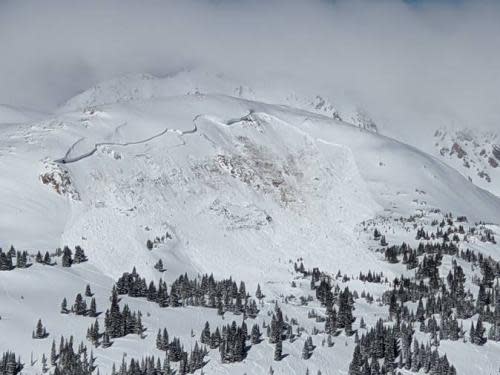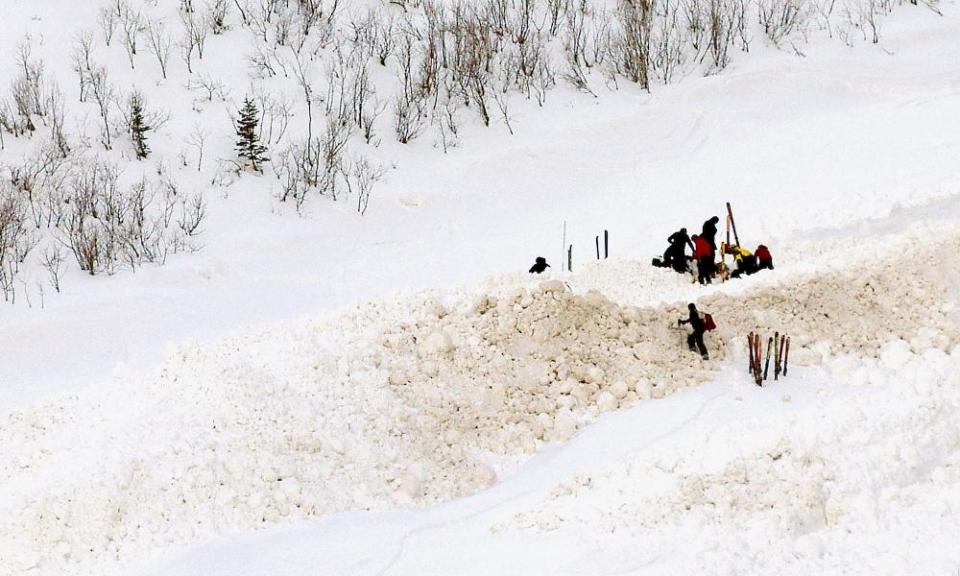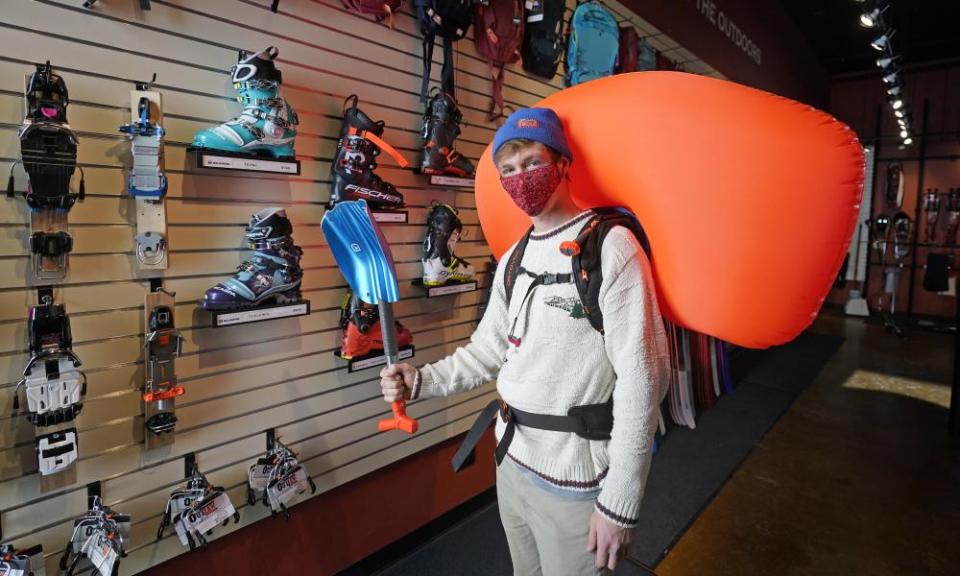Backcountry skiing sees resurgence – and the deadliest week for avalanches since 1910
There was no warning from the snow: no thump as it broke, no roaring as it gained speed, no shaking like an earthquake as it rushed toward the bottom. Maurice Kervin, 25, just noticed a huge crack had appeared beneath his snowboard and shot like a silent lighting bolt down No Name Peak in the Colorado Rockies. As he turned to look uphill, he was hit by a cascade of white that confirmed his worst fears. He was caught in an avalanche.
“A huge slab starts breaking out below me,” Kervin said. “Right at that moment it was like, we’re in it to win it now.”
It’s a story that has been all too common in the western United States this year, with more than 700 avalanches reported in Colorado in February. Many have even been captured on film, like a billowing torrent of snow that briefly buried three snowmobilers in a valley in Utah’s Uinta Mountains.
In February, 15 people died in seven days, the deadliest week for avalanches since 1910, when a 14ft wall of snow swept two stranded trains into a gorge in Washington and killed 96.
The number of fatalities has only continued to grow. Midway through the season, 33 people have been killed in avalanches, already surpassing the annual average of 26.
The forecasters who make a daily assessment of danger level have said these are some of the most dangerous snow conditions they’ve ever seen, with avalanches releasing more often, enveloping broader swaths of terrain and running further than normal.
As resorts have been forced to limit the number of skiers due to the Covid-19 pandemic, more people have ventured into the backcountry, where there are no lift lines or advance reservation systems – and no ski patrollers to lob explosives on hazardous snow.
“If you put more people traveling in avalanche terrain, the chances for a human interaction with an avalanche go up,” said Brian Lazar, deputy director of the Colorado Avalanche Information Center. “And if the snowpack is as dangerous as it is this year, the chances for a tragic outcome go up as well.”
‘We got very nervous’
As with any string of avalanches, it started with the weather. After winter storm Billy dumped up to 20in of snow in late October, the mountains of the western United States suffered a weeks-long spell of dry cold that turned this base into what hydrologists call a “persistent weak layer”.
“Everyone was high-fiving each other because people were skiing early,” said Doug Chabot, a backcountry skier, snowmobiler, climber and director of Montana’s Gallatin National Forest Avalanche Center. “Then it just shut down, which as an avalanche forecaster we got very nervous about.”

Snow is a good insulator, which is why igloos work. In cold weather, water vapor at the warm bottom of the snowpack tends to diffuse toward the dry surface air above. Along the way, it transforms rounded snow crystals into angular “facets” that don’t bond well together.
When thick snow falls on top of that weak layer, as it has been across the western United States in recent weeks, it’s like pizza dough on a pan dusted with cornmeal – it will slide right off. The more snow that falls, the bigger the slides, which are known as slab avalanches.
“It’s like having a foundation that’s crumbling,” Chabot said. “You can’t build a big house on it.”
In Colorado, which is known for weak snow layers, the state forecast center said these are once-in-a-decade conditions. In places like Utah’s Wasatch Range, they’re even rarer.

But as Dave Richards, avalanche department director at Alta Ski Area, told 700 attendees at a recent webinar, it’s not just a snow problem, but also a “people problem … which is a whole bunch of us frothing to go skiing and moving way too fast in a time of serious stress”.
Ninety per cent of avalanche accidents are set off by the victim or someone traveling with him or her. Yet as the avalanche danger has risen, so has the number of people in snowy wildernesses.
‘A cocktail of different dangerous stuff’
The main allure of Alpine touring, in which riders typically strap grippy “skins” to their skis to climb remote mountains, is being able to find untouched powder long after resort runs have been carved up. Its popularity has been growing for years thanks largely to improvements in heel-release bindings and other gear. The splitboard, a snowboard that breaks down into two ski-like halves for skinning uphill, has broadened the sport’s appeal beyond skiers in the past decade.
The coronavirus pandemic accelerated these trends. After Colorado shut down ski resorts in March 2020 and sales of Alpine touring gear like avalanche beacons, probes and shovels jumped up 34%, according to Snowsports Industries America. An estimated 1.3 million people took part in backcountry skiing and snowboarding in the 2019-2020 season.
This fall, sales were 76% higher than the year before. Splitboard producers sold out of several models. In January, vehicle counter in Hyalite Canyon, a popular Alpine touring location near Bozeman, Montana, registered two-thirds more traffic than in January 2020.

“Covid just gave more of a push to say, ‘Why am I going to spend X amount of dollars on a ski pass when I can spend some of that on equipment and get into the backcountry?’” said Nate Bondi, whose Bondi Outdoor Leadership company has doubled the number of avalanche hazard management courses it is teaching this season. But the more people in a backcountry bowl, the more likely that one will hit the soft spot that triggers an avalanche – and the more people are likely to be “caught, carried and buried”, as avalanche forecasters say.
A slide in Wilson Glades in Millcreek Canyon this month tied the record for the deadliest avalanche in Utah history, enveloping seven skiers and killing four. The two groups of skiers there only became aware of one another when Chris Gmitro, who managed incredibly to hold on to a tree as the avalanche roared over him, followed an avalanche beacon signal and dug out a stranger.
Once an avalanche settles, the snow can become as hard as concrete. First responders at one slide in Colorado in February, for instance, broke eight shovels and had to use chainsaws to search for survivors. The small amount of oxygen available in the snow around an avalanche victim’s face is quickly exhausted. After 15 minutes, the chance of getting out alive plummets.
At Wilson Glades, Gmitro and another skier dug two men from another group out alive, but were too late to save four people, including Gmitro’s girlfriend of four years.
Before the season began, many avalanche forecasters were afraid that the growing popularity of backcountry skiing would lead to a rash of newbie deaths. Instead, most of the victims have had years of experience, like those at Wilson Glades did.
Will Miner, a University of Colorado student and mountain guide who is spending twice as much time Alpine touring this season to avoid the resort crowds, said the backcountry now feels crowded too.
“Every popular spot is being overrun with new people, everyone’s secret spots are now public. It pushes [more experienced backcountry skiers] further out, and then it slides and they don’t get lucky for once,” Miner said. “It’s a cocktail of different dangerous stuff mixed together.”
Fatigue and risks
The psychological landscape has been just as fraught as the physical one. Traveling in the backcountry is inherently risky, and the difference between life and death can come down to judgment calls about what lines to ski and how to best approach them.
According to avalanche data analysis done by Ian McCammon, an engineer and mountain guide, backcountry riders’ judgment often falls prey to several “heuristic traps”, including “familiarity”: terrain that a person has skied safely before may not be safe in current conditions. Even skiers with decades of experience may have encountered conditions like this year’s only a few times, which can lead to a bad call.
Another danger lies in the difficulty of resisting fresh powder after weeks of low snowfall, even if the avalanche danger forecast is high.
But Covid-19 may also be muddling decision-making in the backcountry. When longtime backcountry rider Kurt Damschroder wanted to ski a steep slope outside Park City, Utah, in January despite his partner’s misgivings, the pair agreed to meet at the bottom. After an avalanche carried Damschroder 250ft downhill and fatally buried him, the partner told the Utah Avalanche Center that the isolation, financial difficulties and “near-constant stress Covid brings” had “an impact on this accident”.
As people have tired of following coronavirus safety measures due to “pandemic fatigue”, they may also have begun neglecting avalanche safety measures due to “risk management fatigue”, Avalanche Canada has warned.
“It’s hard to say no when you’re bored and your need for arousal is not met,” said Sue Kraus, chair of the psychology department at Fort Lewis College in Durango, Colorado.
But many remain undaunted by the backcountry perils this season. Snowboarder Maurice Kervin miraculously survived the avalanche on No Name Peak by deploying his airbag, an inflatable backpack flotation device, and struggling to stay on top of the snow even as it ran him over a small cliff. A video of the accident from his helmet camera got thousands of views on Instagram.
Since then, Kervin, who is also a bitcoin investor and owner of a small apparel company, has continued to go out on his splitboard several times a week.
He said he’s trying to be more conservative and make better decisions with the knowledge gained from his close call.
“But we’re going to take risks because this is what we love to do,” he added. “Skiing a run on a 2ft day, first tracks, is pretty insane shit, and I’ll be out there looking to do it again.”


